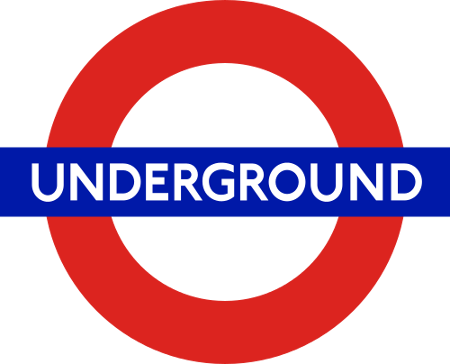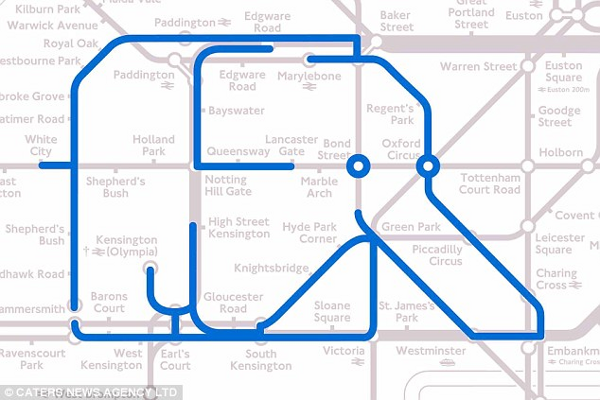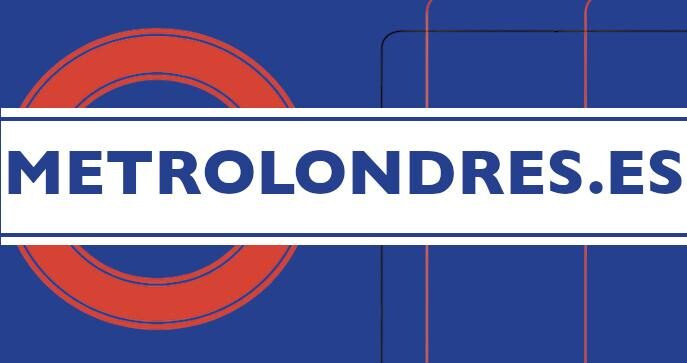Classification of Curiosities
This post is about curiosities of the London Underground. We have gathered so many that they might bore you. Many are the typical ones you can read everywhere, while others required a bit more documentation. We will classify the curiosities into:
- Statistical curiosities
- Historical curiosities
- General curiosities
- Macabre curiosities
- Funny curiosities
- Trivial curiosities
Statistical Curiosities
- Although the London Underground is a network of underground trains (hence the name Underground), only 45% of the network runs through underground tunnels.
- During the morning rush hour, the busiest station is Waterloo, with nearly 60,000 people passing through.
- The line where trains reach the highest speed is the Metropolitan Line. They go up to 60 mph, or about 97 km/h.
- The trains of the London Underground travel at an average speed of 32.8 km/h.
- The underground network has a total of 4,134 vehicles.
- The deepest station is Hampstead on the Northern Line, with platforms 58.5 meters below ground.
- The longest escalators are at Angel Station. They are 60m long with a vertical rise of 27.5m. On the other end, the shortest escalator is at Stratford, with a rise of 4.1 meters.
- Every week, the escalators of the underground travel a distance equivalent to going around the world twice.
- The London Underground is the third longest in the world by kilometers of track, after Beijing and Shanghai, and the third most used after Moscow and Paris.
- The shortest distance between two stations is 260 meters. A journey that takes 20 seconds between Leicester Square and Covent Garden stations on the Piccadilly Line at the not-so-modest fare of 4.3 pounds. However, it is the most frequently made trip by tourists visiting London.
- The longest distance between two stations is on the Metropolitan Line, between Chesham and Chalfont & Latimer stations: 6.26 km.
- The longest tunnel is on the Northern Line and stretches from East Finchley to Morden. The distance is 27.842 km.
- The station with the most platforms is Baker Street, with a total of 10.
- The line with the most stations is the District Line, with 60 stations.
- The lines with the fewest stations are the Waterloo and City Line.
- Waterloo is the station with the most escalators. It has a total of 23.
- The highest station above sea level is Amersham, at 147 meters.
- The total number of lifts in the network is 164.
- The station with the most steps is Hampstead Station, with 320 steps in total.
- There are 14 trips that take less than 1 minute.
- There are 12 stations that have only escalators and 9 that have only lifts.
- The eccentric record of visiting all the underground stations, the Tube Challenge, is held by Andi James and Steve Wilson from the UK. They completed the tour in about 16 and a half hours on May 27, 2011. The Tube Challenge has been featured in the Guinness Book of Records since 1960.
- The busiest day in the London Underground was August 3, 2012, during the Olympic Games, with 4.4 million passengers.
- The average distance traveled by a London Underground train annually is 185,000 kilometers.
- The most repeated phrase in the carriages is Mind the gap
Historical Curiosities
- The first underground trains were steam-powered. The switch to electric trains was what ultimately boosted the development of this network.
- Approximately 30,000 passengers used the Metropolitan Line on its opening day on January 10, 1893.
- The inaugural journey of the first train on the Central Line in 1900 had the Prince of Wales and Mark Twain as guests of honor.
- In 1940, the underground was used as an air-raid shelter.
- During World War II, parts of the Piccadilly Line were closed, and the British Museum stored treasures in the empty spaces.
- The London Underground helped evacuate over 200,000 children to the countryside during World War II.
- The first demolished underground station was Westbourne Park on the Metropolitan Line.
- Queen Elizabeth first rode the underground at the age of 13 (1939).
- The first air-conditioned train started operating on the Metropolitan Line in 2010.
- Alcohol was banned on all London transport, including the underground, in 2008.
Trivial Curiosities
- There is only one London Underground station that does not contain any letters from the word “mackerel”. This is St John’s Wood. By the way, mackerel is a type of fish.
- The only two stations that contain all five vowels in their names are Mansion House and South Ealing.
General Curiosities
- The London Underground is known by the nickname The Tube because of the way its tunnels are built.
- The London Underground was named “The Underground” in 1908.
- The first deep-level electric train line opened in 1890.
- The London Underground logo is called “The Roundel“.

- The Victoria Line was initially going to be called the Viking Line.
- The first baby born on the underground was in 1924.
- The first flat fare or pass for the London Underground was introduced in the 20th century when the Central Line opened.
- Harry Beck, who designed the London Underground map, was only paid 10.5 pounds for his work.
- The phrase Mind the Gap dates back to 1968. It was recorded by Peter Lodge, though now, depending on the station, the voice may be Emma Clarke or Tim Bentinck.
- The only line that connects with all the others is the Jubilee Line.
- The Central Line was also known as the Twopenny Tube due to its flat fare of 2 pence.
- Destination indicators with illuminated panels were installed in 1983.
- One of the levels in Tomb Raider 3 is set in the abandoned Aldwych station, where Lara Croft kills rats.
- The current typeface for the London Underground was designed in 1916 by Edward Johnston.
- The first underground tunnel opened in 1880, running from the Tower of London to Bermondsey.
- Fines in the underground only started in 1994.
- The last manual doors on the underground were removed in 1929.
- The underground only operates 24 hours on New Year’s Eve and for special events.
- Oyster cards have been around since 2003.
- The underground has been managed by TfL since July 2003.
- Filming in the underground costs 500 pounds per hour, plus tax, if your crew has five or more people.
- There is still an old wooden escalator. It is in Greenford on the Central Line.
- Arsenal Station on the Piccadilly Line is named after the football team.
- In the Monopoly game, there are three stations on the board: Liverpool Street, King’s Cross, and Marylebone.
- The London Underground has a film department (Film Office). And it’s no surprise, given that they receive about 200 filming requests per month.
- In Cockney (British slang), the London Underground is known as the Oxo or the Cube.
- The first girl born on the underground was named Thelma Ursula Beatrice Eleanor… if you put her initials together… but it seems this is more legend than truth.
- Hidden in the London Underground map are a series of animal figures.

- A 2011 study concluded that 30 percent of passengers took longer routes because the underground map scales are not accurate.
- At King’s Cross, there is a plaque for Platform 9 ¾, a tribute to Harry Potter.
- At Waterloo Station, there is a metal mesh elephant that appears to emerge from the wall. The material it’s made from gives it such a realistic appearance that it looks like a real animal.
- At Baker Street, the tiles on almost all the platforms have the silhouette of Sherlock Holmes drawn. Sir Sherlock lived on Baker Street.
- The Jubilee Line is the most expensive line ever built. It cost 330 million dollars per kilometer. But it seems they got the platform and train sizes wrong. They could have made them larger.
- It’s unclear if the grey line is called Jubilee because of the monarchy’s anniversary or because of the number of elderly and retired people who use it.
- The first underground carriages had no windows and were upholstered in such a way that they looked like padded cells. And that’s what they were called.
- Men on the underground tend to sit with their legs apart. There’s a story that says it’s because of the magnetic fibers in the upholstery that create a strange anti-magnetic effect. But it seems this isn’t true.
- The Jubilee Line was initially planned to be called the Fleet Line.
- Northfields Station on the Piccadilly Line was the pioneer in using falcons to kill pigeons and prevent them from nesting inside the stations.
- The air in the underground is on average 10°C hotter than on the surface.
- Green grapes are more dangerous than banana peels on the underground. They cause more falls and accidents.
Macabre Curiosities
- Aldgate Station on the Circle and Metropolitan lines is built over a mass grave where it is said there are more than 1,000 bodies buried.
- It can be said that the London Underground has its own wildlife, including woodpeckers, hawks, bats, snakes, worms, and of course, its own species of mosquito (see next).
- One of my favorites. There is a species of mosquito, native to the London Underground, called the London Underground mosquito, Culex Molestus. It was discovered during World War II.
- Half a million mice live in the underground.
- In 2002, a study revealed that the air quality in the underground is 73 times worse than on the street.
- Approximately 50 passengers die in the underground each year.
- The most chosen time to commit suicide in the underground is around 11 am.
- Charles Pearson was the ideologist of the London Underground. Unfortunately, he died in 1862 before the first train was put into operation.
- The first underground accident occurred in 1938 when two trains collided between Waterloo and Charing Cross.
- The worst accident in the underground, where 42 people died, was at Moorgate on February 28, 1975.
- In 1926, anti-suicide pits were installed due to the increase in people throwing themselves onto the train tracks.
- In 1987, a fire killed 31 people at King’s Cross. Since then, smoking has been banned in the underground.
- It is said that Covent Garden station is haunted by the ghost of William Terris, who died in 1897 near the station. Farringdon station is also said to be haunted.
- A 1940 census revealed that more than 177,000 Londoners slept in underground stations.
- The accident with the highest death toll was in 1943. 173 people died in the Bethnal Green tragedy.
- People who throw themselves onto the underground tracks are known as one-unders.
- A 40-minute journey on the underground is equivalent to smoking two cigarettes.
- Victoria and King’s Cross hold the record for the highest number of suicides each year.
If you are interested in some macabre stories about the London Underground: https://www.metrolondres.es/sucesos-paranormales/
Funny Curiosities
- In Piccadilly and other stations, an experiment was conducted by introducing a perfume to mask the underground’s bad smell. This was on March 23, 2001. Just one day later, it had to be removed because people felt sick. The perfume was “madeleine”.
Source:
